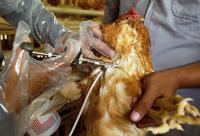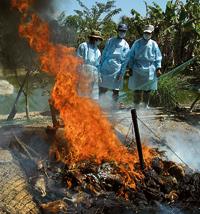 |
 |
 |
 |
 |
 |
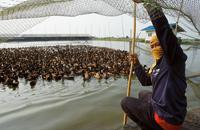 |
 |
 |
 |
 |
Duck farm from Thailand. Farms have set up nets to avoid mixing ducks and wild birds. |
 |
|
 |
 |
 |
 |
 |
 |
 |
 |
 |
 |
 |
 |
 |
 |
Ten years have not yet passed since avian influenza was contaminated by the first man. In 1997, the H5N1 virus of the Influenza A group killed 6 people in Hong Kong, with a total of 18 people getting sick. Subsequent studies showed that the cause of this new disease was the close relationship with contaminated farm-bred birds. For the first time it was confirmed that avian flu could jump the man.
With a million and a half dead birds, Hong Kong took the risk away from the pandemic, but six years later, the H5N1 virus reappeared in that country and another person died.
During this period, in 1999, in both Hong Kong and China, another type of avian influenza virus (H9N2) was found in humans. Four years later, in December 2003, the situation worsened and in Cambodia, Vietnam and Thailand the disease was resurrected. More than 50 people died and more than 100 million birds died in several Asian countries. In any case, it is not a known virus in recent years, but was identified 100 years ago in Italy.
The H5N1 virus is being known and infected mainly by farm-bred birds (chickens, roosters, turkeys), while the most important laboratories in the world are dedicated to isolating and studying its structure. So far, experts have discovered that the virus has several subgroups. These subgroups are identified by two elements, hemagglutinin (H) and neuraminidase (N). In total, fifteen groups of hemagglutinins (H1-H15) and nine of neuraminides (N1-N9) have been identified, so there are different variants of the virus.
 |
 |
 |
 |
 |
 |
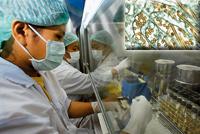 |
 |
 |
 |

 |
Technicians from the Animal Health Institute of Thailand, analyzing bird samples. Above, H1N5 virus (in brown). |
 |
|
 |
 |
 |
 |
 |
 |
 |
 |
 |
 |
 |
 |
 |
Unfortunately, in recent months the avian flu has become news again, as we may be facing a more serious danger. In fact, epidemiological studies conducted in northern Vietnam indicate that the H5N1 virus is changing.
In addition, last May, several wild and migratory birds were found dead on China's Qinghai Lake. In the coming weeks more birds died, reaching a total of six thousand. 'Chicken flu is the culprit', has been published by Chinese scientists in the scientific journals Science and Nature, the two most important in the world. According to some experts, we may be facing the most deadly flu that wild birds have suffered, and scientists around the world are very concerned about the effects that virus mutations can cause.
The transformation of the virus is what most worries scientists. In fact, group A influenza viruses are very variable, they easily avoid patient defenses and, as they are transmitted from one animal to another (or from one person to another), the genetic structure of viruses is changing. In this process, the new variants replace the first versions of viruses.
 |
 |
 |
 |
 |
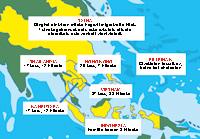 |
 |
 |
 |
 |
Consequences of H5N1 virus in Asia (human) |
 |
|
 |
 |
 |
 |
 |
 |
 |
 |
 |
 |
 |
 |
 |
 |
These changes can cause the virus that only affected chickens to contaminate other animal species such as cats, pigs and migratory birds. The latter pose a real danger for the virus to reach other countries and can infect its population. In fact, migratory birds are responsible for the living risk of spreading the disease west of Europe.
The risk of spreading the disease depends on the virulence of the virus. And, although it seems paradoxical, the greater the death capacity of the virus, the lower the risk of spread, since the disease will kill migratory birds before reaching their destination. The risk may therefore be in a weaker strain of the virus or in a virus carrier species. Bear in mind that carrier species carry the virus but do not suffer the disease.
The fears mentioned so far came true according to the news of the Government of Indonesia on 17 July. An adult and his two daughters, one year old and one nine, died of avian influenza pneumonia. The dead had no contact with chickens, so the virus was transmitted by another contagious agent, the pig, according to some. This family may be the first known case in which the virus has been transmitted from one person to another.
 |
 |
 |
 |
 |
 |
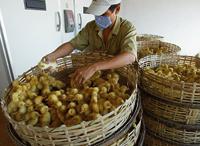 |
 |
 |
 |

 |
For fear of the flu, many Baserritarras have stopped growing chickens and demand for chickens has decreased dramatically. Photo chickens await their sacrifice in Vietnam. |
 |
|
 |
 |
 |
 |
 |
 |
 |
 |
 |
 |
 |
 |
 |
In this case, this would mean that the two influenza viruses of group A have exchanged genetic material and a new virus has been created. For example, if the avian influenza virus and the common influenza virus of humans occur in the same human being, they can exchange genetic material and create a much more dangerous virus. In fact, the ability to kill the avian influenza virus can be combined with the ability to spread the human influenza virus. From there everything is possible and a pandemic cannot be ruled out. At this point, the question is what would be the pandemic, modest, like the one that occurred in 1918, or rougher, like the one that killed almost 50 million people in 1916.
At the moment, what we know is that the H5N1 virus moved quickly, which is faster than other influenza viruses, and that it has the ability to take the genetic matter of viruses from other animals. It is also very pathogenic and contagious. And the more humans become infected, the greater the likelihood of a new, contagious virus among humans.
The measures against avian influenza are coordinated by the WHO and currently there are less than 50 countries that have planned the prevention of the virus. Physical measures such as killing animals in the territories of origin of the virus and limiting trade have been taken. The European Union, for example, has banned the importation of birds from several Asian countries.
In addition to sacrificing livestock from farms, animals have been incorporated. On the other hand, WHO has recommended that people who may be "near the H5N1 virus" vaccinate against the flu to avoid the exchange of genetic material between the human influenza virus and the bird virus. Antiviral medicines are recommended as prevention. Staff who remove bird droppings from farms, as well as wearing special suits and equipment, should take these medications.
In any case, for the drugs used to be effective it is necessary to check that the virus has no resistance to them, otherwise no beneficial effects would be obtained. And there are also problems. The prestigious Washington Post newspaper has stated that since 1990 Chinese farmers have regularly used some antiviral drugs to treat chickens. Therefore, some strains of the H5N1 virus have become drug-resistant amantadine. The news has not surprised anyone, but that means that other drugs will have to be used to treat patients, such as oseltamivir and tamiflu, more difficult and expensive to produce.
WHO believes that tamiflu is the best medicine, but it is expensive, especially for Southern countries. Manufacturing is also slow: pharmaceutical companies need at least 12 months to respond to requests. For this reason, 23 countries in the world are making a previous collection of medicines to be able to combat them in case of pandemic.
In recent months, the Roche laboratory has sent millions of doses at the request of different governments. For example, the UK has applied for doses for 14.6 million people. The Spanish Ministry of Health has collected 30,000 doses and ordered the purchase of medicines for two million people. 150,000 will arrive this year and 1.85 million remaining doses next year.
However, this medicine does not solve the problem. It may delay pandemic deployment but not paralyze it. This would require a vaccine against the H5N1 virus, but research has not yet achieved the goal in its entirety, although hopeful results have been obtained.
A group of Vietnamese scientists, for example, will experiment in humans with a vaccine against this virus. The results obtained in monkeys are good: after vaccination the animals were injected the H5N1 virus and the monkeys developed antibodies. In Spain, the Ministry of Health talks with two laboratories to implement a production plant against chicken flu.
 |
 |
 |
 |
 |
 |
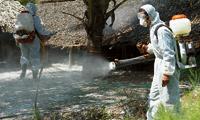 |
 |
 |
 |

 |
Millions of birds have been vaccinated in Asia and to limit pollution have burned dead and disinfected the surroundings. |
 |
|
 |
 |
 |
 |
 |
 |
 |
 |
 |
 |
 |
 |
 |
Meanwhile, we can say that we are facing another chapter of chicken flu. At this time it seems that the virus has changed in nature and has become much more contagious. WHO can activate the fourth phase of pandemic alert if it confirms that the death of the family in Indonesia is a case transmitted from one person to another. Thus, the collaboration of all countries will be necessary if you want to control a possible virus that endangers everyone.
| Phases of the pandemic to the world health organization (moe) |
Phase 1
|
There is no influenza virus in humans. In animals there may be a contagious virus, but the risk of infection is low.
|
2nd phase
|
There is no influenza virus in humans. A virus that can infect humans is detected in animals. |
3rd phase
|
Human infection. Does not spread from person to person or there are isolated cases |
Phase 4
|
Human infection. It spreads from person to person, but only in certain cases. |
Phase 5
|
There are many infected humans, but contamination from one person to another remains limited. The virus is increasingly adapted to humans. |
Phase 6
|
Pollution has spread throughout the population. |
|
|







